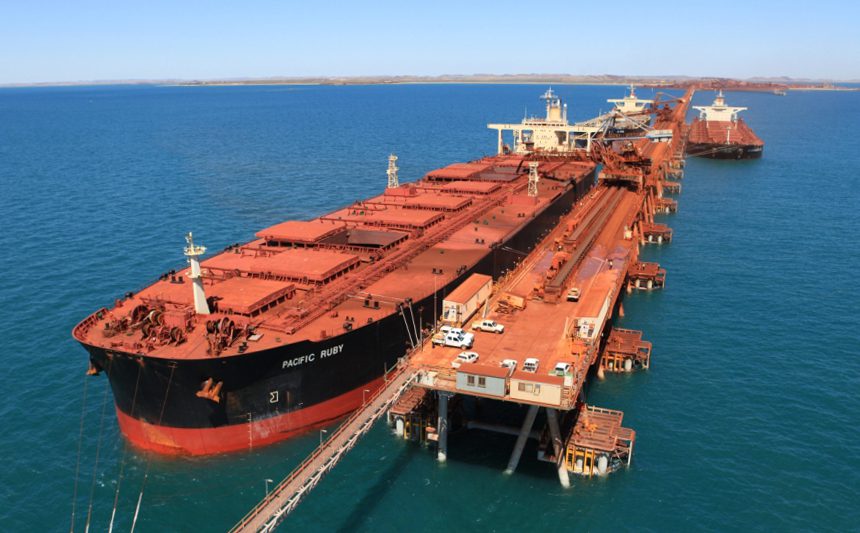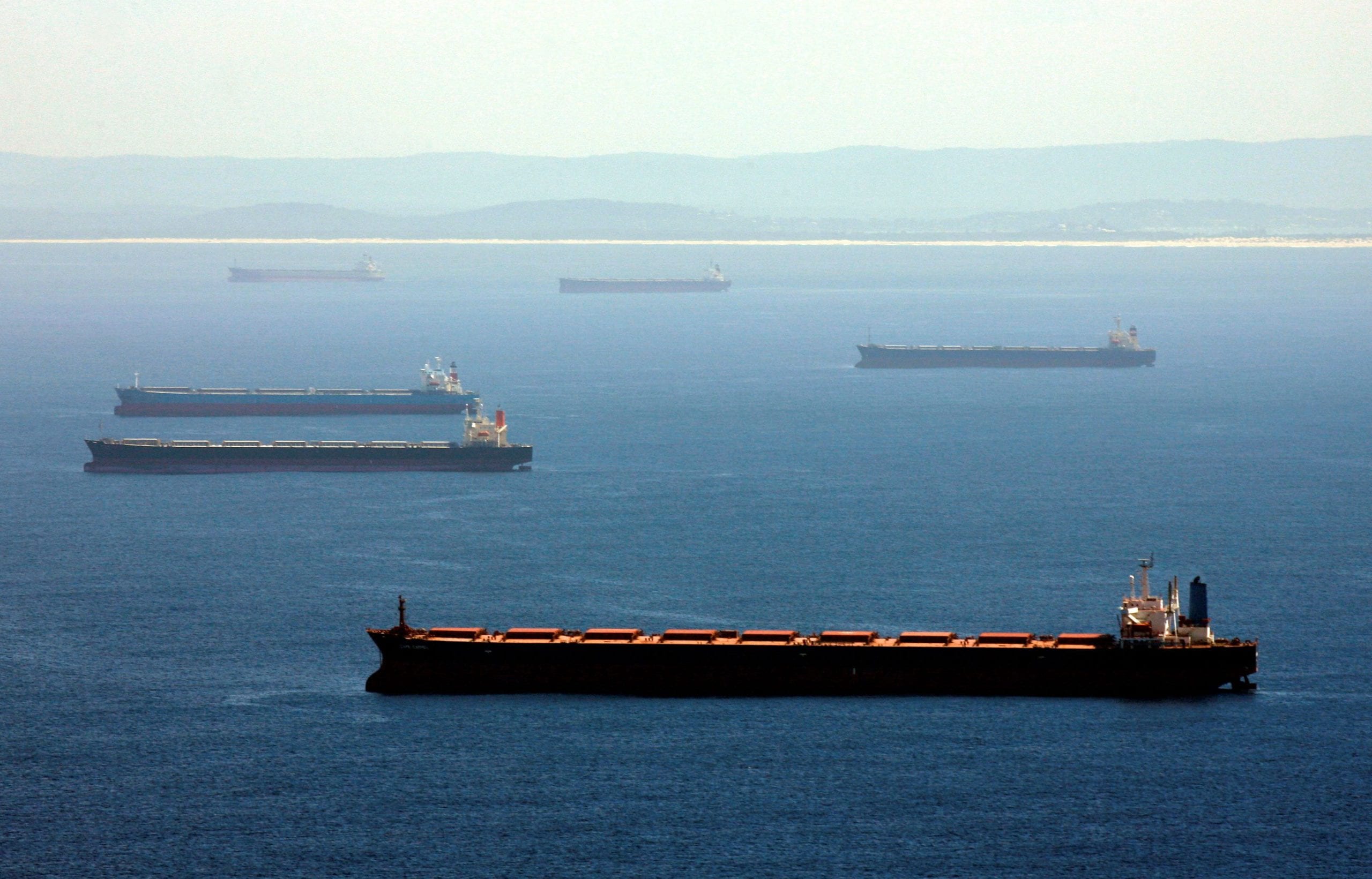Iron ore is loaded on to the Pacific Ruby, a Capesize bulk carrier berthed at Rio Tinto’s Cape Lambert port. Image (c) Rio Tinto
By Naomi Christie
Aug. 8 (Bloomberg) — Australia’s plans to export more iron ore this year than any nation ever is driving up shipping costs by 80 percent. Increased sales from Brazil before year-end means freight rates could go higher still.
Rio Tinto Group and other miners will ship an extra 97.8 million metric tons from Australia, equal to more than 600 cargoes for Capesizes hauling the ore, says Clarkson Plc, the world’s largest shipbroker. Brazil will add another 12.4 million tons, the first expansion since 2011, with shipments accelerating in the second half as the weather improves.
While the 38 percent slump in ore prices since the end of last year is threatening to curb the growth in cargoes, Morgan Stanley still expects global seaborne supply to top 1.3 billion metric tons in 2014 for the first time ever. The flood of ore is helping freight companies contend with their own glut, with orders for new vessels at a near three-year high.
“What is needed is a little spark,” Marc Pauchet, a London-based analyst at Braemar ACM, the second-largest publicly traded shipbroker, said by e-mail Aug. 5. “The increase in production in Brazil and Australia in the second half might just be it.”
Capesizes, each hauling about 160,000 tons of ore, earned $13,376 a day on average this year, compared with $7,432 a year earlier, data from the Baltic Exchange in London show. That’s still below the $14,500 that Arctic Securities ASA estimates owners of five-year-old vessels need to break even. Rates priced at $8,504 today.
Freight Swaps
Freight swaps that traders use to bet on, or hedge, future shipping prices indicate rates will gain in the second half. Capesizes will earn $12,250 a day this quarter, rising to $21,250 in the final three months of the year, according to data from Clarkson’s derivatives brokerage.
They’ll earn an average of $21,789 in 2014, 53 percent more than last year, and $28,000 in 2015, according to the medians of 23 analyst estimates compiled by Bloomberg News.
The extra ore supply from Brazil has a disproportionate effect on shipping because it’s three times further from China than Australia. China consumes two-thirds of the world’s seaborne iron ore, feeding mills that produced 779 million tons of steel last year, or about half the global total.
The most important demand measure for shipping is ton miles, multiplying cargoes by distances. Brazil increased exports in the second half in seven of the past nine years, government data show.
Second-Half Bias
“There’ll be a catch up in the second half of this year,” Doug Mavrinac, a senior shipping analyst at Jefferies LLC in Houston, said by phone Aug. 5. “It should have a very substantial effect on Capesize rates in particular.”
Vale SA, the Rio de Janeiro-based company that supplies about 85 percent of ore from Brazil, said July 24 that it will sell 321 million tons this year, maintaining a prior target. The estimate implies shipments will jump by about 5.3 million tons a month in the second half compared with the first six months, according to Commodore Research & Consultancy, a New York-based adviser to ship owners.
It would require 17 million tons of Australian cargoes to the Chinese port of Qingdao to generate an equivalent amount of vessel demand, data compiled by Bloomberg show. China accounts for about 69 percent of global demand for cargoes and Asia 87 percent, Clarkson data show.
Disproportionate Increase
“We could have a disproportionate increase in ton-miles,” James Leake, the research managing director at Arrow Shipbrokers in London, said by phone Aug. 5. “Things can change very quickly.”
Vale is protected against rising spot rates as it has longer-term charters, Jose Carlos Martins, the company’s head of ferrous metals, told reporters yesterday.
“We are hedged for a big volume, our needs are practically covered. If eventually we need something else, we go to the spot market,” Martins said in Rio, adding that the company plans to double its iron-ore shipments to China in the next five years. “Now, as we boost production volumes and we boost exporting volumes, we will need to hire more ships, that’s unavoidable.”
Benchmark iron-ore prices in China averaged $108.82 a ton so far this year, the least since 2009, according to data from Steel Index Ltd., owned by McGraw-Hill Cos. They peaked at $191.90 in 2011, spurring mining companies to add output.
Ship Supply
Increasing production from Australia and Brazil will deepen a global glut through 2018, according to Goldman Sachs Group Inc., which predicts the raw material will average $80 in 2015 from $106 this year. Global seaborne output will exceed demand by 72 million tons this year, 175 million tons in 2015 and 323 million in 2018, the bank said. Upside risks will be limited this year in the absence of loosening by China.
The world’s second-biggest economy will expand 7.4 percent this year, according to the median of 54 economist estimates compiled by Bloomberg. While that’s about three times what they expect for the global economy, it will be the nation’s weakest growth in almost a quarter century.
That’s curbing growth in steel output, the driver of demand for ore and the ships that deliver it. Production of the alloy expanded at a 4.8 percent pace in the first six months compared with a year earlier, according to World Steel Association data. The increase was the smallest since 2012.
The capacity of the global Capesize fleet will increase by 4.6 percent in 2014, about the same as in 2013 and the second consecutive year that expansion has been slower than that of trade in iron ore, Clarkson data show. There are 293 Capesizes on order, according to data compiled by IHS Fairplay, a Redhill, England-based maritime researcher. While that’s the most since about September 2011, it compares with as many as 766 in 2009.
The largest Capesize owner is Nippon Yusen Kaisha, according to Clarkson. The vessels comprise about a quarter of the Tokyo-based company’s total fleet capacity because it also has ships hauling cargoes including oil and manufactured goods.
“The market is going to be 200 ships shorter this year than last,” said Mavrinac of Jefferies. “Given that, rates should strengthen pretty nicely.”
–With assistance from Jasmine Ng in Singapore and Juan Pablo Spinetto in Rio de Janeiro.
(c) 2014 Thomson Reuters, All Rights Reserved

 Join The Club
Join The Club











